a medieval tour of ireland
a virtual scrapbook account of my time on an archaeology trip to ireland! reflections on traveling, adventure, medievalism, and learning to think archaeologically.
I spent the first half of June on a study-abroad program in Ireland— specifically, a program hosted through the Galway Archaeology Field School. I wanted to share this experience here— an extended travel journal, along with some of my reflections on my trip. It was such a privilege to be able to experience Ireland like this, and in many ways, this is a love letter to the country.
If you’re interested in Irish history, medievalism, or travel— this post is for you! I had an amazing time in Ireland— I can’t even begin to put into words how special this trip was— and in this post I’ll be sharing the details of my adventure, from music I listened to, clippings I collected, towers I climbed, and the thoughts I jotted down along the way.
I feel so moved and irrevocably changed by this trip as it truly felt it reignited a passion in me for exploration and learning, and I want nothing more than to share my experience here and to continue pursuing medieval history and archaeology. Enjoy!



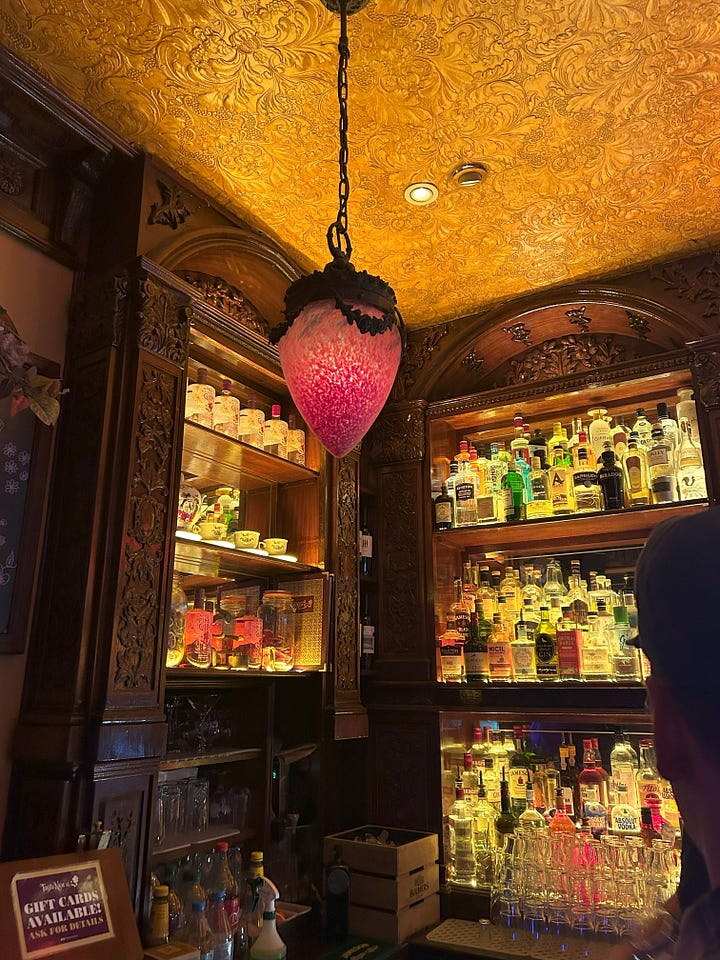
After arriving in Dublin and spending the first weekend getting to know Galway, our program began on Monday with a visit to one of my favorite sites: Aughnanure Castle.
Built in the late 15th century, the castle was the stronghold of the Gaelic O’Flaherty clan, in the towerhouse and bawn style. To access the towerhouse, you take a short hike beside some grazing horses and a small stream, crossing into the bawn (grassy courtyard surrounded by fortified walls) via bridge.
From the outside of the castle, the defensive effectiveness of the towerhouse style castle is evident; several boxes (balistrarias) protrude from the castle with arrow loops cut into them, allowing for defense via archers posted within to aim at intruders with virtually no blindspots. I got to climb into these boxes as they were accessible via the (harrowing) spiral staircase in the front corner of the castle. The balistraria was narrow inside, leaving little room for comfort, but you can still peer out the arrow loops and gaze out on the bawn sprawling out below.
Entering the castle from the ground floor, one finds themself susceptible to attack via murder hole; a gated opening in the ceiling from which rocks and arrows could rain down upon aggressive visitors.
The need for such extensive measures of defense can be chalked up to clan fighting, but also to the Anglo-Norman invasion of Ireland in 1169, from which point on Ireland became forcefully Anglicized, often violently.
While Aughnanure’s interior spaces weren’t furnished, the spaces themselves were well preserved. Looming barrel vaults formed the ceilings and the remains of wickerwork can be seen imprinted into the plaster above.
What struck me the most about Aughnanure was how firmly it stood against its landscape. Walking up the stone bridge, the sky darkened and wind picked up. I learned quickly that the Irish aren’t lying when they say that they experience every season in one day. Inside the castle, the wind howled against the thick walls. I could only imagine how eerie that would have felt on a medieval night, especially if you weren’t lucky enough to have a chamber of furs and candles.
And that’s something that I meditated often throughout the trip: the nonlinearity of time; the intentional attempt to perceive a lived past while in the present. I cannot fully articulate what I mean by that, but I often find myself trying to feel the past’s presence when I visit sites like these. I think we as humans are compelled to attempt to access the past a space may have held, even if that past is distant and irretrievable. There is an instinct to dig around, to explore, to penetrate a liminal space in time wherein the past can exist. I imagine it like layers on a photoshop canvas: myself, on one layer, surveying the site and exploring alongside friends; the past unfolding on another.
At each site, no matter how ruined and crumbling, I tried to focus not only on the educational enrichment it provided, but on holding an intentionality within myself. A recognition of why I was there and who was there before— whose feet wore away grooves in the stairs?
It can be a haunting feeling, but not a necessarily negative one. Wistful, maybe, to try to place yourself in an in-between, a liminal embodiment of the space and time you occupy.
Aughnanure felt particularly Arthurian to me. Tucked away amongst Yew trees bent in the wind, it felt like a mysterious castle a knight of the round table would stumble across, wherein a trial of his virtue would unfold. But even in a less fantastical sense, it is easy to imagine the lives of the non-elites here, those who worked for the O’Flaherty’s, who experienced the space differently: someone would have shoveled the latrines, aimed at invaders from the balistrarias, a beekeeper would harvest honey (for mead!) and a genealogist would have documented the family. And there’s a whole added dimension to the women who’s realities aren’t wholly accessible to us yet.
Aughnanure being the first site to visit felt right to me— it put me in this headspace of intentionality, of accessing the past, and of reading spaces for what they held and hold.
In 970, a Viking camp formed along the banks of the Shannon and became the grounds for the building of four successive castles. In 1250, a Norman fortress built upon an Earthen mound brought in settlers. By 1425, the MacNamaras built the castle that now stands, but it was shortly taken over by the O’Briens. The O’Briens later professed loyalty to the English king under Henry VIII so they could maintain their lands here as Earls and pawns to the Anglicization process. In the later 18th-19th centuries, the land became host to plantation families, and the castle itself was restored to its 1425 state in the 1940s-50s.
Bunratty is what I can only equate to Colonial Williamsburg in America— an immersive historic amusement park. And while historians have engaged in discourse as to whether or not costume and reenactment are appropriately educational, I loved it. It’s silly, a bit on-the-nose, great for children (and girls in their early 20s, evidently), and it gave us as a group an opportunity to explore a landscape and a time that spanned medieval to modern Irish history.



The castle loomed— it was massive. A central square base held massive central rooms, like the great hall, while the four turrets on each corner held private chambers, kitchens, latrines, etc. Unlike Aughnanure, Bunratty was well furnished, allowing visitors to conceptualize how the spaces were used (even if a tad inaccurate). My favorite rooms were the dining/great halls. Up until the late medieval period, these spaces were considered to be communal. There was, of course, a spatial hierarchy within the rooms, but farmworkers and kings alike congregated here to eat, talk, and drink together at the end of each day. I can only imagine what it was like navigating those spiral staircases after a chalice of mead.
Bunratty’s catalogue of wall decor was fascinating to me. From massive tapestries to antlers fixed to the walls, it was a kind of distinct medieval decor I particularly enjoyed; a bit dark and brooding, but I can also imagine how warm and full the rooms must have felt with a fire burning and the mead flowing…
Throughout Bunratty, several carved statues of mermaids hung from the ceilings. A sucker for mermaids myself, I loved these guys, but even moreso because they had antlers attached. I had to do some digging because I am entirely obsessed with this fusion of sea and land creature imagery. There was obviously an abundance of deer at Bunratty— we even saw a beautiful red elk near the regency house— but I wondered what particular meaning was ascribed to antlers? and why adjoin them to a mythical creature of the sea? I found that this particular style of lamp is called a Lüsterweibchen, a style of German antler chandeliers. They were incredibly popular across Northern Europe in the late medieval period, but their symbolism is still unclear. Perhaps it was a sort of trophy taken from the fallen deer and repurposed, or even a symbol of Christ in the form of a stag1. Regardless, I loved their presence in Bunratty and am entirely obsessed with the combination of imagery, creating this distinctly medieval cryptid-ish creature.
As I said, Bunratty was also the site of plantation families. The regency era house still stands fully furnished, and regency gardens sprawl across the terrain. The folk park includes a village with a vintage tavern where we did try mead (take a shot every time I mention mead in this segment) and many animals (like peacocks!) have free reign throughout the park. I particularly loved seeing the Irish Wolfhounds, sleepy from their morning walk.
Now, allow me to take a break from castles to share a wrapup of what was in my ears on my various escapades (in museums, walking around Galway, or sleeping on the bus and train).
My favorite song to listen to while in Ireland was Jig of Life by Kate Bush. She wrote the song while in Ireland, which can definitely be heard in the intense swelling instrumentals. Bush noted that “stimulus from the outside,” inspired the song, and this comes through: the very atmosphere of Ireland lies in the heart of the song. This was one of my favorite songs to listen to driving through the countryside, and it once again evoked that feeling of nonlinearity, of occupying a transient space in time; even the lyrics nod to this: “I put this moment, here! I put this moment— here! I put this moment— over here! Can’t you see where memories are kept?” Part of the appeal of this song to me was the escapism— how easy it was to feel the instruments and the culture intrinsic to their sound and presence in the song, how right it felt of a song to listen to while exploring Ireland.
While Jig of Life evokes the distant Irish past through instrumental folk music, I also got a bit into Kneecap, a West-Belfast based hip-hop group that raps almost exclusively in Gaeilge as a revolutionary act against the English occupation of the North of Ireland and as an act of radical preservation of the indigenous language of the land. The group has recently come into heat for criticizing the government of both England and the U.S, in regards to the United State’s involvement in the genocide of the Palestinian people— a struggle that many Irish express solidarity towards due to the parallel histories of the two lands. Regardless of the censorship they face worldwide (with their recent Coachella set being censored for expressing pro-Palestinian messages), the band embodies the newest generation’s contributions to a century long struggle for a free and united Ireland, and with that, for the liberation of all occupied lands at the hands of capitalist imperial powers. (I’d recommend watching their film Kneecap!)
Another contemporary Irish band I’ve had in constant rotation is Fontaines D.C. A lot of their music feels reminiscent of the post-punk era, with the sounds of The Cure and Depeche Mode peeking through.
And of course, Sinead O’Connor, the Cranberries, and Enya were all in constant rotation.

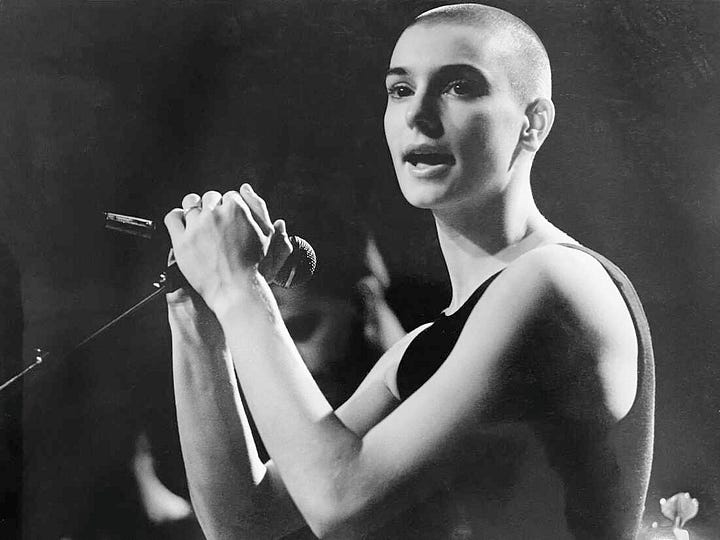


St. Brendan’s Cathedral, Clonfert
Early one morning we stopped at a quaint little Church of Ireland church in Clonfert. Activity at the site dates back to the 6th century, when Saint Brendan was active, but the church standing dates to the 1100s. The central doorway is one of it’s most attractive features, with registers depicting Celtic patterns, animal figures, and gorgeous carvings. The sculptural program carries on into the interior of the building, where I was particularly taken with a little mermaid figure carved into the wall at the nave crossing.
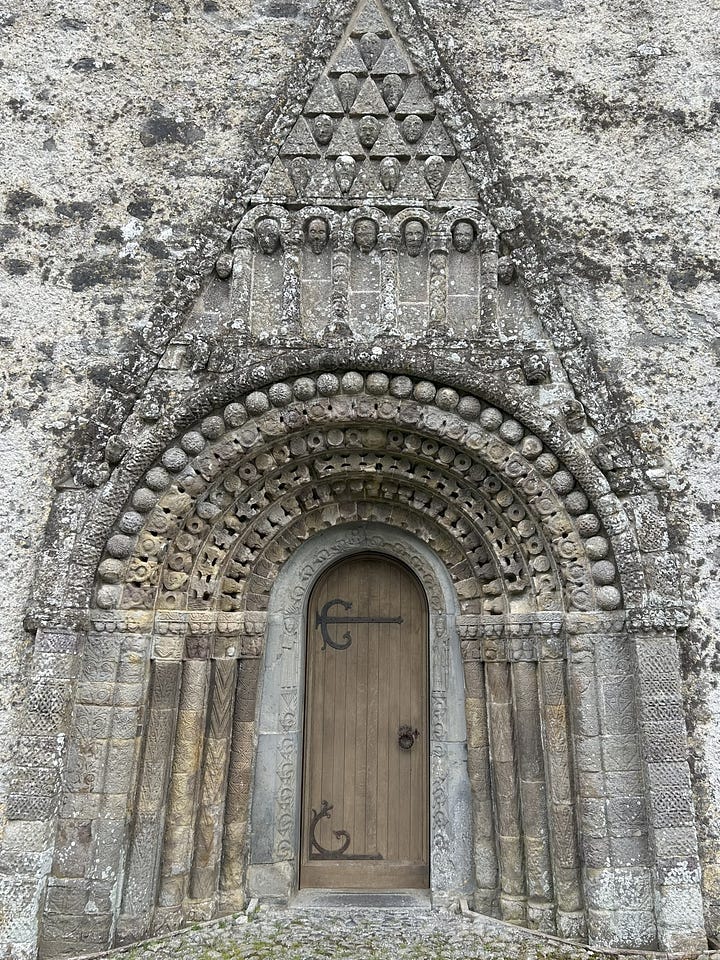

Clonfert was a beautiful space to explore, and was particularly interesting to see after we had familiarized ourselves with the ruins of many medieval churches. Because this one is still in use, it is fully intact and preserved. Aside from a few newer details, it provided a good basis of what some of the other sites we’d visited would have looked like.
Saint Brendan is (supposedly) buried just outside the church’s doorway, but one of the most fascinating aspects about this site wasn’t necessarily the church itself, but something tucked into the woods just next door.
A nature path just next to the church leads to a tree designated as a sacred spot; visitors leave whatever they have in their pockets or on them if they feel so moved to do so. I left a euro beside a prayer card for Saint Philomena. I didn’t know anything about her off the top of my head, but a later search found that she was a saint who had pledged virginity and refused to marry Emperor Diocletian; he tried to have her drowned, tortured to death, and finally beheaded. She happens to be the patron saint of young women, which is fitting enough, so I later bought a small pendant to carry around of her image. Aside from my own contribution to the tree, people left rosaries, pendants, jewelry, prayer cards, candles, religious figurines, and even more everyday stuff, like socks, baby diapers (not my favorite contribution but I digress), and ribbons.
The practice of leaving prayers or devotional items on a designated tree seems to track with the concept of Rag Trees— a kind of guerilla religious act. Initially a Celtic superstition wherein rags (often of sick loved ones) would be tied to trees which were seen as symbols of connection to the spirit world/underworld due to networks of roots underground, the ideas seemed to blend with Catholicism and extended to become spots of devotion. Both versions of the practice seem to be focused on intentionality— you may be moved to leave something, but focusing your energy on a particular desire, person, or energy is key. I did not have anything particular in mind when leaving behind my token, other than taking notice of the Saint Philomena prayer card someone else had left, so I suppose my intention was guided simply by a desire to be a part of something, to keep the rag tree alive, so to speak, but a more whimsical and delusional part of me likes to think I was subconsciously moved by Saint Philomena’s connection to young women., being one myself.
After Saint Brendan’s Cathedral, we followed the river Shannon to Clonmacnoise, a 6th century monastic site founded by Saint Ciaran. Monasteries always catch my attention, for their dual nature of holy and domestic spaces, but this one was particular interesting to me as it had a secret third purpose. One that isn’t really all that secret because I’ll tell you— it was a pilgrimage site!
I don’t know what it is about the notion of pilgrimage, especially medieval ones, that excites me. Maybe it’s the adventure of it all, the idea of someone being so devoted to something that they up and defy fate to get from point A to B. Maybe it’s the scrappiness of it— virtually anyone could up and leave to go on pilgrimage at certain points in the medieval period. I think anything can be a pilgrimage. This trip was, for me, in many ways a pilgrimage. But maybe I’m just taken by the romantic image of a pilgrimage (thanks Chaucer). Either way, entering Clonmacnoise alongside other tour groups, I couldn’t help but feel that we were enacting a warped mirror image version of what the site was intended for, where instead of hiking with the clothes on your back across the Irish landscape, we bounced around on the hilly roads alongside the Shannon in a minibus and joined the swarms of other tourists with our notebooks and phones.
Entering the site, a timeline on the wall notes that the first recorded pilgrim at this site was a man names Aedh, son of Oriel, who died on pilgrimage. Rip Aedh, he would have loooooved our minibus.
The site itself is a bit of a maze of graves marked with Celtic crosses, a roundtower overlooking the Shannon, and the crumbling remains of a cathedral, Saint Ciaran’s chapel, and a women’s church farther along the river. A newer installment was a helicopter pad for Pope John Paul II’s arrival at the site in 1979, where he spoke to the people of Ireland and held an outdoor mass. “Young people of Ireland, I love you,” he proclaimed, a rhetorical plea at a time wherein the faith of the Irish young was wavering.

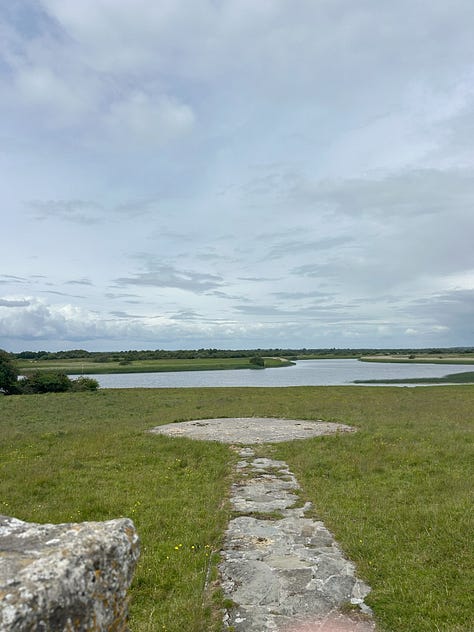

That this site occupied a space not just in the distant past but in a much nearer reach of our historic memory marked it as particularly interesting to me. The site holds a significant collection of celtic crosses, which don’t survive often into modern history. While the draw of the site is likely Saint Ciaran’s chapel and the draw of a distant medieval past, some of what remains of this site mark the existence of the most common of people. One cross/grave slab in the museum is labeled as “a prayer for Tuathal, the craftsmen.” While craftsmen (depending on their specialty and contributions to society) were certainly not on the bottom rung of society, they were far from sainthood status, and yet their time spent here is preserved all the same as Saint Ciaran’s. I was moved by it, and by the bones of pilgrim’s past, names and lives lost to time, but a mark left nonetheless— a mark on a site which has a history spanning the deepest reaches of the medieval period all the way up to debates surrounding the legalization of contraceptives in Ireland (no thanks to John Paul II).
We had free reign on the weekends, so a group of us took a daytrip out to Inis Mor, the biggest of the Aran islands off the coast of Galway— notable as being the filming site for Banshees of Inisherin!
About 800 people live on Inis Mor today, most of whom speak Irish as their first language. The island is dotted with thatched cottages and covered in handmade stone walls. Over several centuries, islanders built these walls walls across the entire island, enclosing pasture and farmland. When you’re at higher points on the island, you can see the walls snaking across the land, dividing it up without sacrificing the island’s lush foliage and scenery. We unfortunately did not have time to see everything on the island in our short visit, but the oldest ring fort on the island dates to 1100 BCE. In the fifth century CE, churches and monasteries were founded across the islands.
In the 17th century, Cromwell terrorized the catholic and indigenous Irish, threatening them to go to “hell or Connacht,” so many Irish people took to the west coast to escape persecution. Churches on the Aran islands were destroyed at the hands of Cromwellian forces, but those living on the islands and on the west coast learned to adapt, creating unique agricultural methods to make the land arable and adapting to the environment with the resources they had available— wool for knitting, thatched boats, and seaweed collecting. Islanders lived in clachans, or hamlets, and knitting and kelp harvesting were lucrative. Aran island knitting is still prominent today, if slightly touristy.
Growing up in the coastal south, my image of an island is far from what Inis Mor had to offer. Because of it’s unique climate and 350 million year old geographic features from sea sediments, the island supports arctic, Mediterranean, and alpine plants alongside one another. The beaches were a mix of porous rocks and sand, with seaweed wasdhing up all over. The water was a vibrant light blue at some points on the island, and a more icy grayish blue on others. It is my philosophy in life that I must swim in any body of water presented to me, but on this particular day I’d made the ill choice to wear a vintage sweater and jeans, so I guess I’ll just have to go back for that swim.




Once we reached the island via ferry, we spent the day walking around and exploring. I would love to go back and see everything on the island, as we really only covered a small portion, but the bit we saw was lovely! Animals grazed or lazed about in their stone walls, and though I turned green on the ferry ride back to Galway, we did stop to see the Cliffs of Moher.
Before spending the night in Tipperary as we plunged further into the heartland, we stopped at the Rock of Cashel. This site is entrenched in lore associated with Saint Patrick. Prior to the introduction of Christianity to Ireland, Cashel was the seat of the Munster kings. In the 5th century, Saint Patrick converted the king of Munster upon the rock, where the baptismal well remains. More than 500 years later, in 1101, the site officially became a church site as it was donated by the king of Munster. Because of this, the site features a wide range of both Christian and Celtic imagery, with Saint Patrick’s cross overlooking the surrounding valley and Celtic crosses dotting the landscape.


While the site is particularly notable for Cormac’s chapel, where frescoes remain on the ceiling, I was moreso taken by the monumentality of the site. From what remains of it, the church is towering, with a massive belltower at its central crossing, supported by a huge vault. The nave culminates in a tripartite window, and the sheer height of which really contributes to the sense of sanctity within the space. I’ve not much else to say about this site, but I was truly taken by the otherworldliness of it; maybe in part because the site is perched high upon a hill overlooking the most flourishing region of Irish farmlands, but once you climb up the rock and walk into the cathedral, you feel like you’ve entered a different realm. Even though the ceilings have since crumbled and parts of the walls have vanished, once inside the structure, it feels as though the elements can’t reach you. There is a comforting sense of isolation up on the rock— like a hermetic solitude, being so close to the sky, to God in theory.
Something else that struck me about this site was its continuing sense of history. In 2011, the then Queen Elizabeth visited Cashel on her tour of Ireland and within the cathedral walls met with a member of Sinn Féin (the political branch of the IRA). Gerry Adams denied to meet with her (rightly so) but a member who lived in Cashel stepped up. It sometimes seems that there isn’t a place in Ireland not touched by the English— many sites bears the scars of Cromwell; the peasant homes at Bunratty left abandoned by famine; stickers echoing Kneecap’s plea to “Get the Brits out,” dot city walls and signposts. So for this site, one so deeply engrained in Irish history and culture, to house the crossing of two intrinsically opposed forces— especially when one of those forces is the embodiment of a violent imperialist regime and Ireland’s oppressor— is strange. Stranger so, to think that the English were the ones who tried to cleanse Ireland of Catholicism, and yet to have the gall to play diplomat in a space that is a testament to the survival of Catholicism against the English. This made me meditate a bit on the living history of a building, especially a ruin, and what spaces really mean; what and who they hold; what they’re intended to hold, and how history lives and breathes and continues unfolding in these spaces, long after their lifetimes fizzle out and they become something secondary; history unfolding within a site designated as history itself.
After Tipperary, we spent a night in Kilkenny; we familiarized ourselves with the city that night, and the next morning our professor gave us a walking tour of several medieval sites. Because Kilkenny is a bustling city, the medieval sites across the city have been upkept and preserved. We started at the Gothic St. Canice’s cathedral (1202) at the top of the hill. The cathedral’s interior was gorgeous— the nave is punctuated with arches splitting off the side aisles and culminating in a tripartite window of stained glass. My favorite part of the interior were the sarcophagi with effigies of the entombed on top of them— I really loved this little knight guy.
Outside of the cathedral, we climbed the roundtower. The inside of the tower held a series of wooden ladders, getting steeper and steeper as the tower narrowed towards the top. Then we climbed the final few steps and were greeted with an aerial view of the whole city! Roundtowers dot the landscape of Ireland, but few are actually accessible to us now. St. Canices’ is one of two in the country that visitors can actually climb. Their original purpose was simple belltowers, which invites a kind of romantic image of a medieval monk scaling the ladders to call villagers to worship.


St. Canice’s cathedral is a unique example of the way a building occupies a space; the buildings in its periphery were built to accommodate its monastic community, and later the city expanded beyond the boundaries of the cathedral.
We also made a stop at the Black Abbey in Kilkenny, a smaller church tucked into the city. We only briefly perused the inside, as monks had begun preparing for mass. As someone who hasn’t attended mass before, I honestly felt drawn to stay and watch. The thought of my first time attending mass being one held in a quaint city church in Ireland was tempting. I was entranced by the low tones of the monks reciting Latin together, a jumble of bass echoing through the pews. The church itself retained much of its medieval form (see the vaulting here!) but really in that moment I was more enraptured by the peaceful flow of worshippers filing in while the monks droned on in harmony. Perhaps after seeing so many churches (some still in use, some in complete ruin), this completed the picture for me by actually filling the church with worshippers and friars alike. I am fascinated by the way religion presents itself, between different faiths or even just different sects of the same faith— that the same god can be worshipped in such vastly different spaces is fascinating to me. Especially in the context of Irish faith, but that’s an entirely different tangent.
On our second-to-last day of the course, we had our big “assessment,” of sorts, which was really just learning how to survey using real equipment and methods. We drove out to Temple Cronan. The drive itself was gorgeous— we drove along the coast for a bit and then through some hills dotted with cattle and boulders. It reminded me a biiiit of parts of the Appalachias, but moreso like a hinterland, where Sir Gawain would set off looking for the Green Knight, or maybe where Grendel would run off with his prey. These kinds of things are easy to feel in touch with when you’re in a space foreign to you, even more when the fog hangs low and the population is few and far between.
To reach our site, we had to take a short hike through some cattle fields and then we came to Temple Cronan, a very small medieval ruin. The running theory is that the original building was erected in the 600s by Saint Cronan, and later rebuilt in stone in the 1100s. There have been no real excavations done of the site, so it felt kind of special to survey it— even if just for practice and course evaluation.
We split up into groups and my group decided to tackle the elevation drawing of the stones making up the doorway. Since we were new to the process, we were assigned to work with this limited space and thank god for that, because it took us nearly an hour to scale just the lintel block. The hardest part was scaling it appropriately. Even though the math of it all wasn’t too complicated, the process of taking what we saw and measured and putting it onto paper in a completely accurate way proved to be frustrating at times. But after a sandwich break and a short hike to a prayer well hidden away along a short hiking path, we finished our scale drawing and got the seal of approval from our professor.




I didn’t have much in the way of reflection at this site— it was a beautiful site. A tiny little church out in this strange landscape, and I particularly enjoyed exploring the nearby nature, but I did take to heart that maybe elevation drawings are not my forte, and in the world of archaeology I’d much rather be doing the dirty work of digs than drawings, but I’m never going to take for granted learning a new skill, especially as someone who finds learning new skills incredibly daunting and terrifying. I’ve wanted to get into archaeology as a possible career pathway for a while, but I felt behind in terms of what my university could offer to me, and the idea of putting myself out there and finding alternative ways to learn felt so scary. But at the end of the day I learned the simplest lesson— that it’s worth putting yourself through the discomfort than dwelling on not knowing how to do something and letting the opportunity pass you up.
Over the course of our adventures we made a few more unique stops— ones that certainly qualify as archaeology but were far different from our usual church/monastery/castle.
One morning— bright and early, still coming off our hotel breakfast in Tipperary, our professor pulled to the side of a rural road, pointed at a hill, and told us we’d be going to the top. The hill in question was deceptively steep, with a narrow path to follow and knee-high dew covered grass to slip and slide on. Expecting some semblance of architecture at the top, we were surprised to find that the hill itself, actually, was the “site.”
We had climbed Knockgraffon motte. A motte is an earthen mound which would have held a wooden structure on top; the motte would have been surrounded by a courtyard and a palisade called a “bailey.” So what we were standing on was the remains of this setup, one built in 1192 by the Normans.

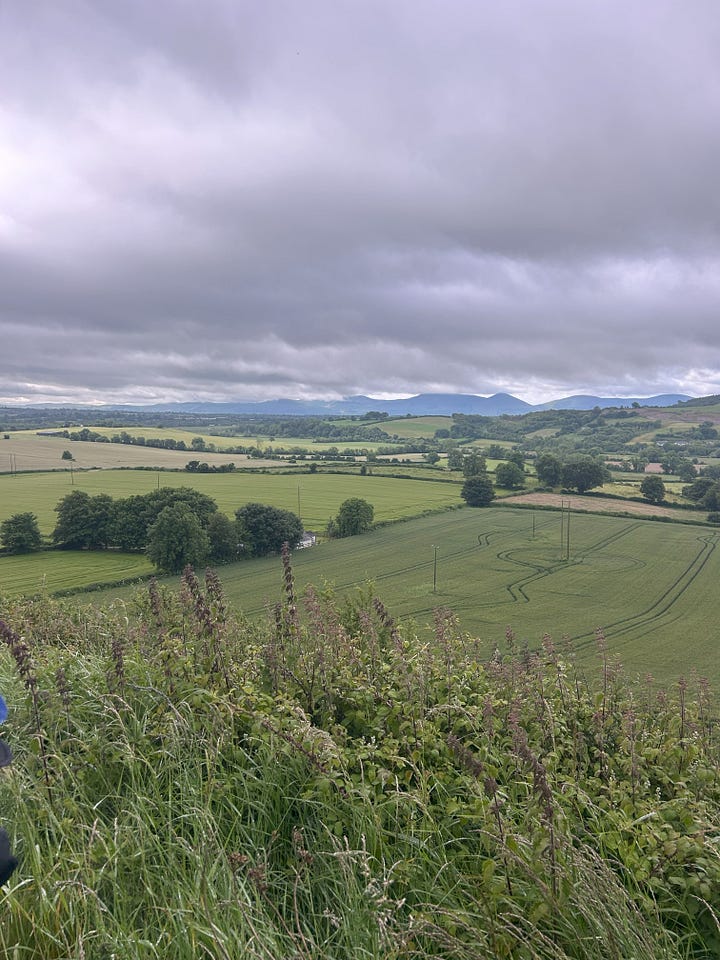
Minimal remains of the man-made structures that would have stood here, and the hill itself is natural. It begs the question of what qualifies as an archaeological site? I don’t doubt that it does qualify— I’m sure much human ephemera remained in the strata of the hill, and the motte-and-bailey structure certainly left a mark geologically on the landscape, but that we took a brisk hike early one morning to simply stand on top of a hill and then slip and slide our way back down struck me as rather silly. I appreciated the adventure, but I found it interesting that this particular site seems to represent a collision between man and environment; one in which the environment practically wiped away the human aspect of the site, and what remains is a hill from which we can say “this happened here,” and climb back down.
The second of our stranger adventures was in Lackan. Once again our adventure started with our professor pulling off to the side of the road and leading us down a road and off into the woods. As the ten of us scaled a crumbling brick wall into the forest, a local boy asked if we needed help finding “the cave,” and that should have indicated some of what we were getting ourselves into.
The forest was thick— and muggy. One thing I was unprepared for was the Irish humidity. Growing up in the south, humidity is nothing new to me— what was new to me was that you could step off the road in a random spot in Ireland and dive headfirst into a dense rainforest, where the air is muggy and mosquitos descent on you like a swarm of locusts. Even though it was just off the side of the road, the forest we’d climbed into was thick with growth, and we had to navigate over and under many fallen trees and bat our way through thick vegetation before we reached the site- a rath, or ring-fort. While, once again, what remains of this site is largely earthen, it drew my attention greatly. The ring-fort was a set of several earthen ring-shaped mounds, concentric to one another. The rath is a type of early medieval settlement, one occupied between 600-900 BCE, and many can be found across Ireland (including one on Inis Mor!) but went largely out of style by the 10th century. This ringfort, in Lackan, had three rings and three ditches between them. We climbed on top of the rings, which were overgrown with ferns and surrounded by the dense forest of trees growing up from the ditches, when we finally came upon the aforementioned “cave.”
The “cave” was actually a souterrain— a sort of underground corridor. The enterance to the souterrain was a simple hole in one of the rings, surrounded by ferns, leaving only enough room to slide yourself in before disappearing into the darkness. A “ramp” made up of just a sloping rock allowed for us to slide into the chamber easily, and explore the L-shaped passageway. It was a bit murky and damp in the chamber, and I failed to get any worthwhile pictures of the rockwork on the inside— simple stone masonry walls, but fascinating to see within this subterranean context. Climbing back out of the cave was more difficult than getting in, but one of my favorite parts of each site we explored was climbing around, exploring in the most immersive way possible. I found myself on top of a series of cloister arches, inside a dungeon chamber, exploring a latrine block, and evidently, in this underground cave with a bat I wasn’t too keen on getting to know.
Other highlights of places explored but not mentioned in this post:
★ Castle Cahir, co. Tipperary


★ Ormond Castle, co. Tipperary
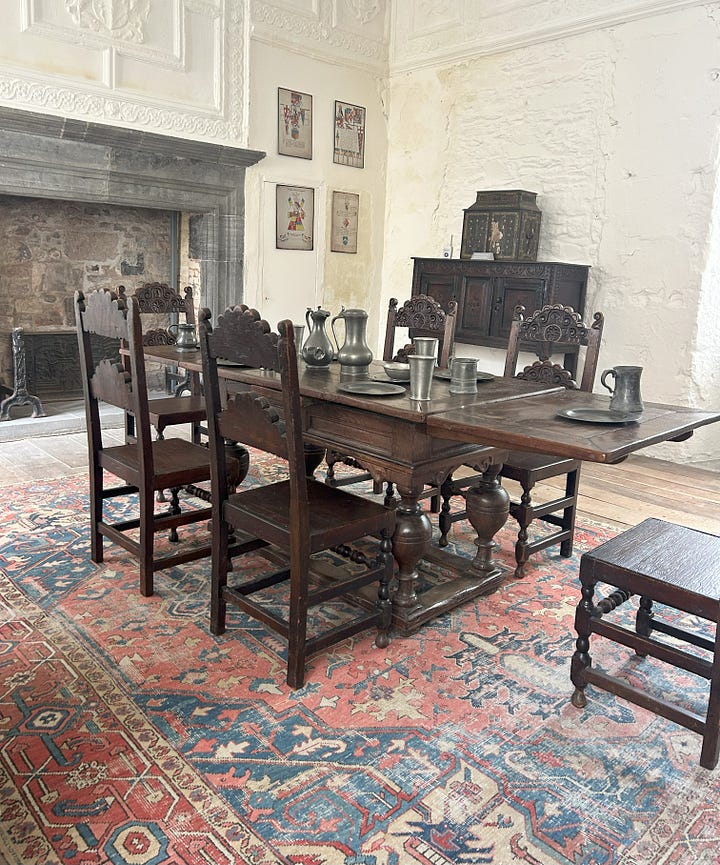

★ Athassel Abbey, co. Tipperary


★ Kells Priory, co. Kilkenny

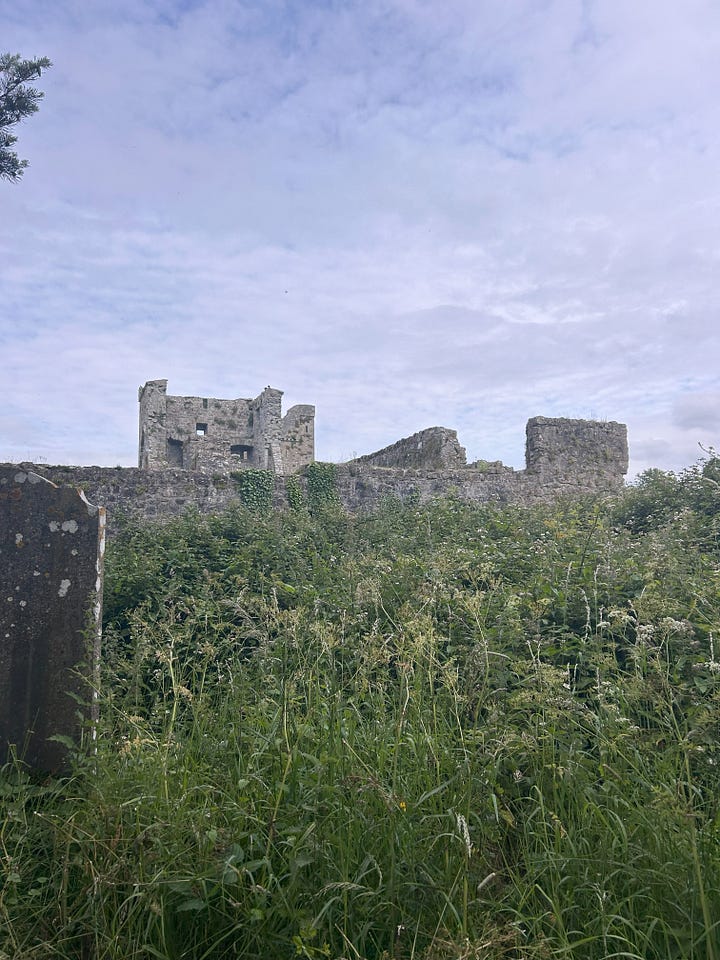
★ Pallas, co. Galway

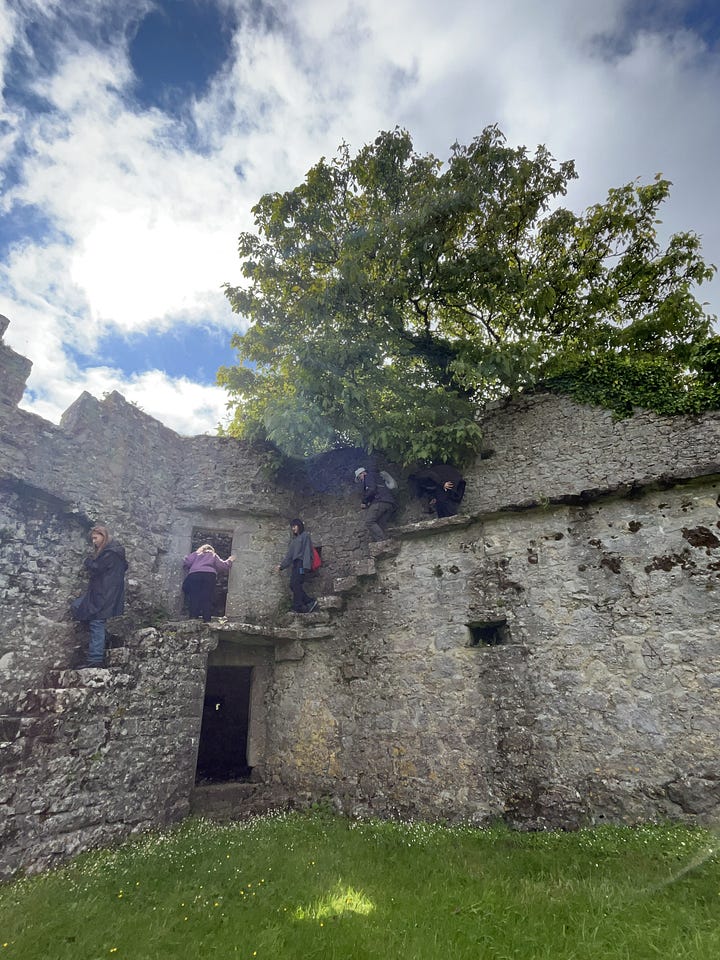
★ Ross Errilly Friary, co. Galway



I left Galway early Saturday morning and took the train straight to Dublin. I will die on the hill that America needs highspeed rails but it just falls on deaf ears anyways. I got into Dublin early— around 8:30 and was greeted with torrential never-ending downpour, but as soon as I dropped off my luggage at Trinity, I was off.
I stopped into the Seamus Heaney museum first; I had initially come to Dublin with a plan of a few places I definitely wanted to go as I was only there for about 24 hours, but I was surprised to find the name Seamus Heaney on my apple maps, so I added that onto my itinerary, stopping in to the National Library of Ireland exhibition.
My familiarity with Seamus Heaney stems from his translation of Beowulf— in my opinion the most accessible and poetic version of the poem— but that is not to say it is the Beowulf translation to end all translations. In fact, my first exposure to Beowulf was the Fulk translation which— again, my opinion— is the most verbatim translation, truest to the old English verbiage (although very confusing and dull). I would recommend reading this essay (“Don’t read Heaney’s Beowulf") from Dead Language Society if translations are of interest to you! I also have many thoughts on Heaney’s translation (especially after visiting the exhibition) that I intend to share later on, but I have a lot of appreciation for Heaney’s Beowulf as something that spans time, language, colonization, and culture— he wrote a foreword to his translation depicting his internal struggle with operating within the Old English language as an Irish person. I see Heaney’s Beowulf as something poignant and timeless, something that sits in a liminal space between the contemporary situation of colonial existence and the deep reaches of the past, culminating in something of a radical translation of an indigenous oral tale transmitted into written word by a colonial power and preserved in that state for centuries.
But the Heaney exhibition just marginally touched on his work on Beowulf. A tad disappointing from my medievalist perspective, but he had also done so much original work in his lifetime that it frankly made sense that his translations were sidelined.
The exhibition was well curated and featured a vast expanse of materials, but I took note of a few points of interest to myself:
In the ‘70s, he wrote North, “exploring the kinship between ancient bog bodies and ongoing violence in Northern Ireland.” I have a particular affinity for bog bodies, or anything that comes out of a swampy hinterland for that matter, but bog bodies span Ireland’s environmental history, from prehistory to the recovery of disappeared people from the Troubles. I bought a copy of North and am excited to dive into it!
Much of Heaney’s work centers around the landscape of Ireland. “In Excavations, we encounter his childhood and family, the countryside he grew up in, and the poems that draw on that experience. The bog, a familiar part of the Irish landscape, appears frequently. For Heaney, it was a powerful symbol— the wet, earthy peat of the bog is an environment that preserves and remembers everything.” Again— I’m a sucker for a bog. Growing up in the south, the swamps and marshes had a similar draw; there is something fascinating about these Othered landscapes; in Beowulf, Grendel hails from the peat bogs and fens— it’s as though the human imagination associates bogs and swamps with life and death simultaneously; like the swamp births things that are Wrong, decaying, decomposing, haunting. That these ideas are such a central part of Heaney’s work is exciting! I’m looking forward to diving into this world; a world he’s created but exists in as well. The poem Mossbawn was highlighted in the exhibition, two poems in dedication to Mary Heaney in North. As I mentioned earlier, a bawn is a sort of medieval enclosure of land around a building; to see these terms and spaces described in such a poetic way at the end of my trip, after having explored the country and trekked through the bogs and ringforts and bawns, it felt like the perfect way to wrap the trip up, and purchasing a copy of North seemed like a gesture of preservation, like I was holding the memories and the spaces in the words within the book.
Another point of interest to me was the display of Heaney’s poem, Whatever You Say Say Nothing. Prior to my trip I read Patrick Radden Keefe’s Say Nothing: A True Story About Murder and Memory in Northern Ireland, and since returning I finally decided to start watching the FX production of the book; I would recommend this book to anyone interested in the troubles. Say Nothing describes the IRA policy wherein, even under torture, volunteers were instructed to fix their view on a point on a wall so as to avoid looking at their British interrogators and prevent disclosing information. Heaney was heavily invested in the Troubles, hailing from Derry, and many of his poems revolve around the struggle of the Irish people, between the desire for independence from British occupation from the sectarian angle of the conflict, growing up Catholic in Derry he had his foot in the race whether he liked it or not, and he chose to write about the troubled world he grew up in.
I found myself very moved by the Heaney exhibition and left with a few books, of course, before moving on to the National Museum of Ireland (Archaeology). The museum was setup spatially so as to guide visitors through chronologically (however this did cause quite a bit of bottleneck and crowding…but I have no expertise in museum curation or management so I can’t get on them too much), with side rooms acting as diversions from the main timeline.
My favorite part of the museum, and maybe of Dublin as a whole, was one particular area in the prehistory display. The room was dark, with large cylinders separated from the main flow of traffic. If you wanted to see what was inside the cylinders, you had to walk down inside them via a downward slope, making it feel as though you were entering into a different world, a more private, quiet space, away from the chaos of tourists and glass displays. Within each of these separate displays were bodies— bog bodies. I really appreciated the way movement was guided by the setup of the exhibition here. It forces viewers into a more intimate space, allowing them to sit with the bodies and engage with the displays in a more private, solemn means. That these bodies are thousands of years old and weren’t privileged to any proper burial rites at the time of their violent deaths makes it feel as though this is their resting space, and the arrangement of space within the museum does seem to implicitly evoke a sense of intimacy and respect.
Being me, I was a bit overstimulated int he museum generally speaking, with so much to see and so so so so many people crowded around, but walking down into these displays felt like refuge, like I had truly entered another space, another world. It allowed me to really sit with what I was looking at— to reckon with the life lived within the skin and bones before me. The first body wasn’t particularly well preserved, just bones really, but his hair was shining and coppery, with the curls flowing around the remains of a forehead and jawbone, leaving the impression of youth and life in this shell of a body.
The second bog body was by far the most awe-invoking. The Clonycavan man is 2,300 years old, but his skin, face, and hair are still incredibly well preserved. The bottom half of his body is missing, possibly destroyed by a peat harvesting machine, but what remains of him is morbidly fascinating. I used to be incredibly squeamish— couldn’t watch horror movies or look at the mummy displayed in my hometown’s natural history museum (weird because why does South Carolina have an Egyptian mummy!)— but the Clonycavan man didn’t make my stomach turn, despite the twist of his neck and flattened head. Instead I felt incredibly touched by the preservation of his body; the skin folding around his organs, the slit of his open mouth, his ear pressed against his skull. It’s not often that we see dead bodies (hopefully), and especially not ones that are 2,300 years old. To see this man, murdered and tossed to the wolves, pulled from the mud and preserved against the odds of time, it felt weirdly privileging; like I felt incredibly lucky to be able to see something so unique, horrifying, haunting, to see death in its raw form.
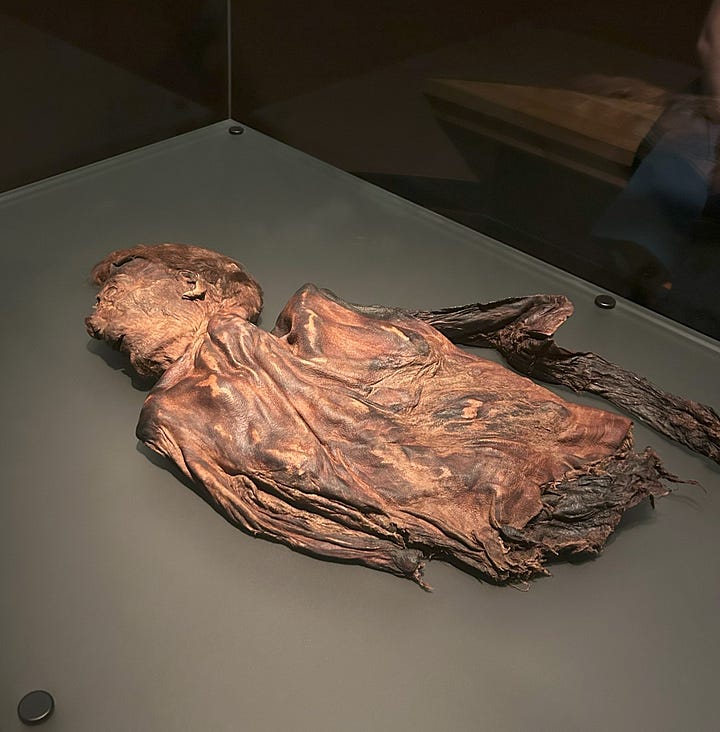

We think of death as something unspoken and unseen; we tuck death away, addressing it with reverence and distance, and yet the body before me is dead; it held life two thousand years ago, but no more. But despite it’s absence of spirit and life, it didn’t feel like a husk. It felt like I was looking down at the last moments of a short-lived life, one incredibly different from mine but still just as human. And it again comes back to that mindset of intentionality. I could have easily stopped by these exhibits, nodded at the bones and kept going, but standing before the bodies it felt I owed them recognition, like I had to flip a switch in my brain and really process that this is a dead human body before me, an artifact, a story, a life. It’s an effort to intentionally reckon with the time and place an artifact occupied, to imagine how it had been used in the past. It’s even more of an effort to know that the body before you had a chest that rose and sank with his breaths, had hair he combed and gelled, had a bracelet he wrapped around his arm.
The rest of the National Museum was wonderful! I particularly enjoyed seeing the pilgrimage badges on display, costumes, and an audio-element reciting sentences in Old Irish and Old English.
I wrapped up my day in Dublin with the National Gallery and then did some much needed shopping for the rest of the day, before meeting up with friends from my program for food and drinks before staying in the Trinity dorms! I would have loved to spend more time in Dublin but after two weeks of walking and drinking my bank account and body were ready to pack it in.
A HAUL!!!
Aside from souvenirs for friends, I treated myself to quiiiiite a few drinks and dinners, but also to a small book haul, mostly from Charlie Byrnes in Galway and a few from Dubrays and Hodges Figgis in Dublin:
After having gotten back there are sooo many books I wish I’d bought while I was there, especially by Irish authors. I bought Catastrophe, Nakba II by Fintan Drury, a former correspondent during the troubles. I would urge everyone to read this book as it covers the events following October 7 2023, and emphasizes the pure cruelty of Israel’s tirade against the Palestinian people. I was drawn to buying this because of how strongly Ireland displays its solidarity for the Palestinian people, and was interested to see how the struggle of the Irish people is comparable (if on a much smaller scale) to the current destruction of Gaza. Drury’s writing is accessible, his recap of the past two years is accompanied by insight into the workings of the political body of Israel with particular attention paid to Netanyahu’s vitriol, and he does not shy away from writing into stone the atrocities we have witnessed and the clear imperialistic agenda of American investment in Israel.
Other books I’ve read that I felt kept me well-informed or at least set the vibe for the trip:
★ Say Nothing - Patrick Radden Keefe
★ The Famine Plot - Tim Pat Coogan
★ We Don’t Know Ourselves - Fintan O’Toole
★ Killing Thatcher - Rory Carroll
★ Intermezzo - Sally Rooney
I left with a couple of souvenirs and treats for friends, and a heap of assorted ephemera, like receipts, tickets, and wine labels to glue into my travel journal, which I’ve been slowly putting together as part of a personal effort towards enhancing my physical media collection, especially when it comes to personal memories, thoughts, and journals.
Some final words on this trip:
When I was younger, I knew all I wanted to do was see as much of the world as possible, in the most authentic way possible. Sometimes that means Being a Tourist, which isn’t my favorite means of traveling, but other times, it means simply exploring. Like, boots in the mud, nooks and crannies kind of exploring. When I’m home, in South Carolina, one of my favorite things to do is drive out into the woods and check out old abandoned churches left behind as far back as the 17th and 18th centuries. But as I got older and realized that being alive is expensive, I always thought I’d put exploring on the back burner. I am endlessly glad I took the jump of participating in this program— I met the most amazing people and felt truly immersed in the experience. I went out every night to try a new pub, listen to new music, and see where the night would go. I did big girl things on my own, tried new foods *broke my 9 year vegetarian streak (worth it), and did something that, frankly, my anxiety made me feel I couldn’t do. And it really made me feel inspired in a way I haven’t really felt since starting college (because college in the states really beats it out of you, especially when your University president is dissolving all of our DEI initiatives!) and now I am working on my post-grad plans with a little less dread and a little more passion and spark.
I hope you enjoyed reading this little scrapbook of mine. I am endlessly thankful for this opportunity. Feeling reinvigorated, impassioned, in love with Ireland, and ready to set off on my thesis and post-grad plans. I also have lots of writing ideas in the works so keep an eye out for a zombiegrrrl revival after whatever last semester was.
★ with gra, ZOMBIEGRRRL (cailínzombie) xx
https://www.themagazineantiques.com/article/object-lesson-lights-from-the-dark-ages-the-lusterweibchen/











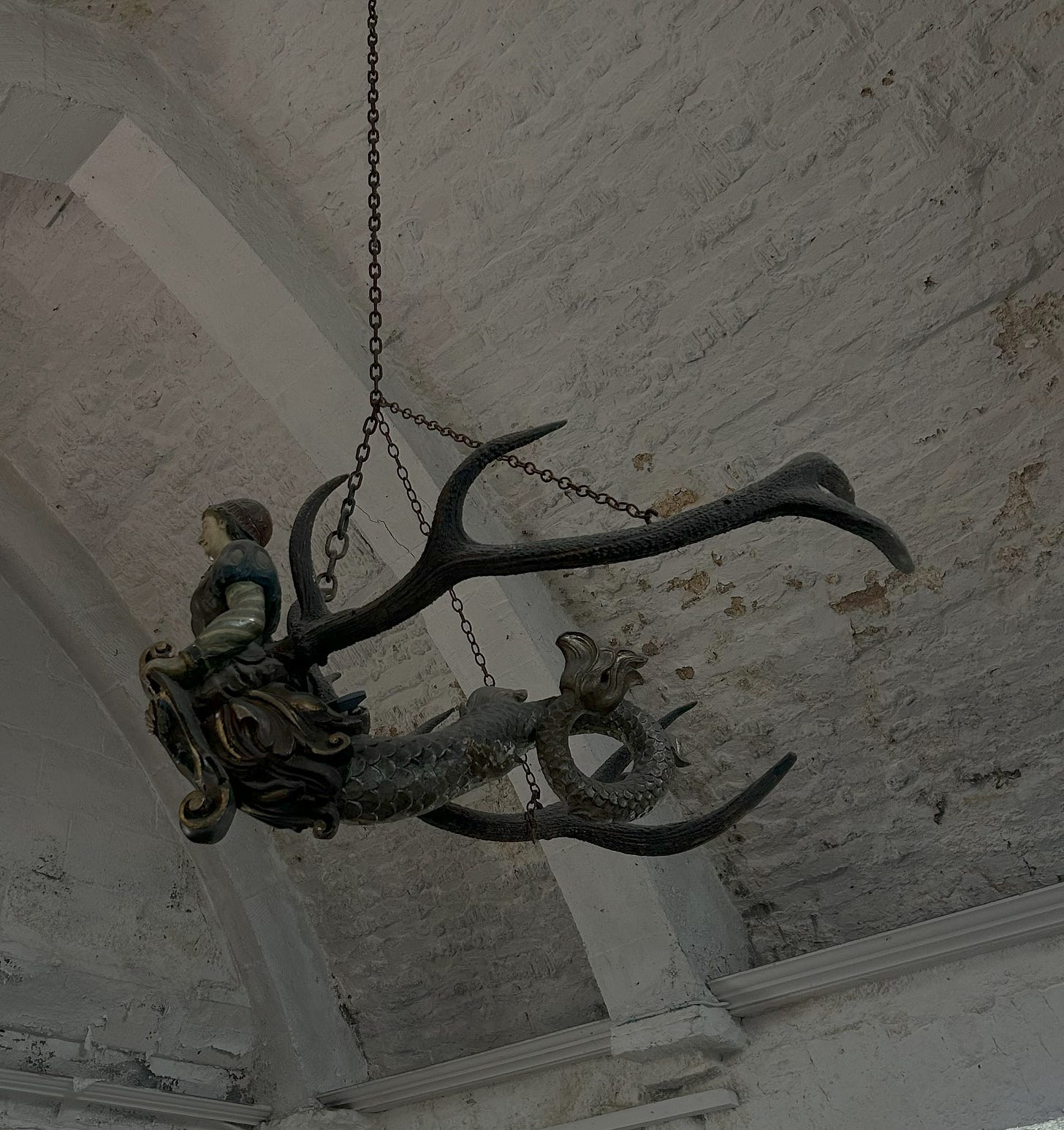






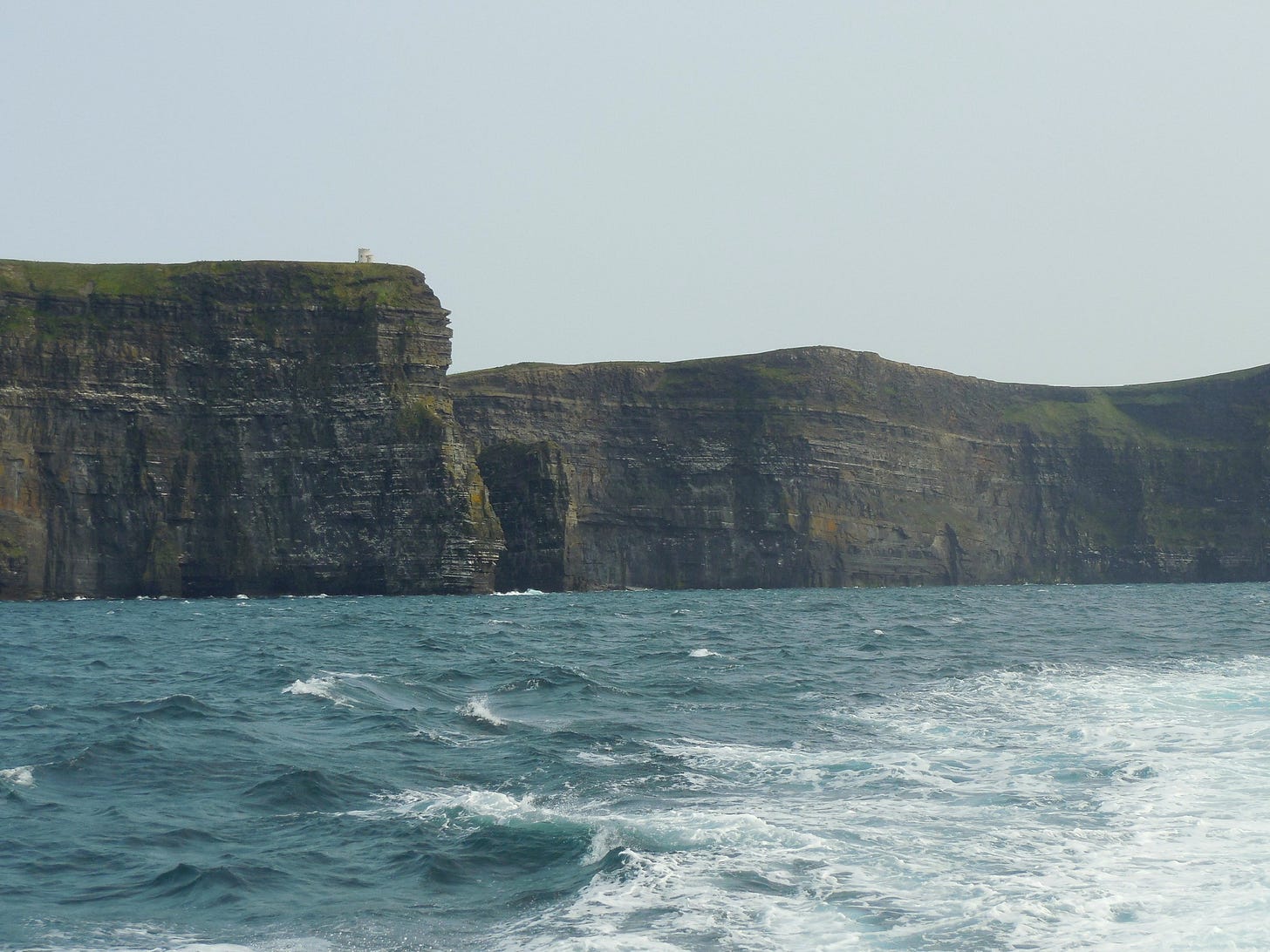






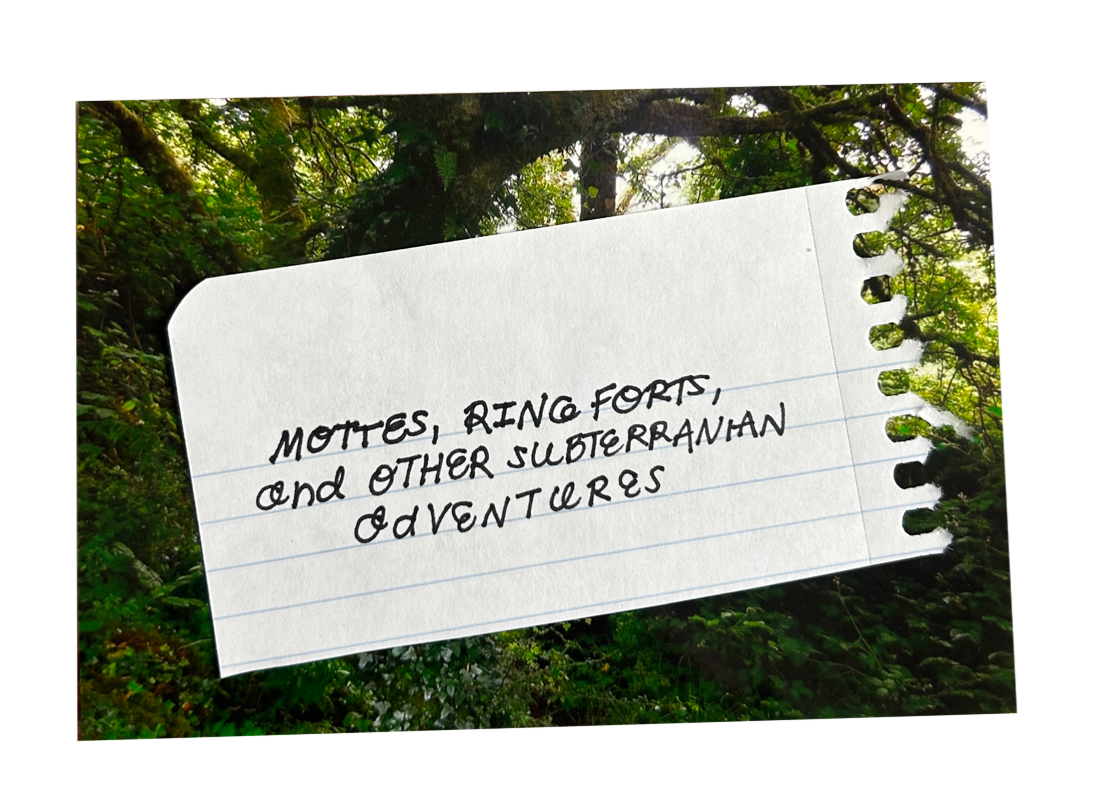


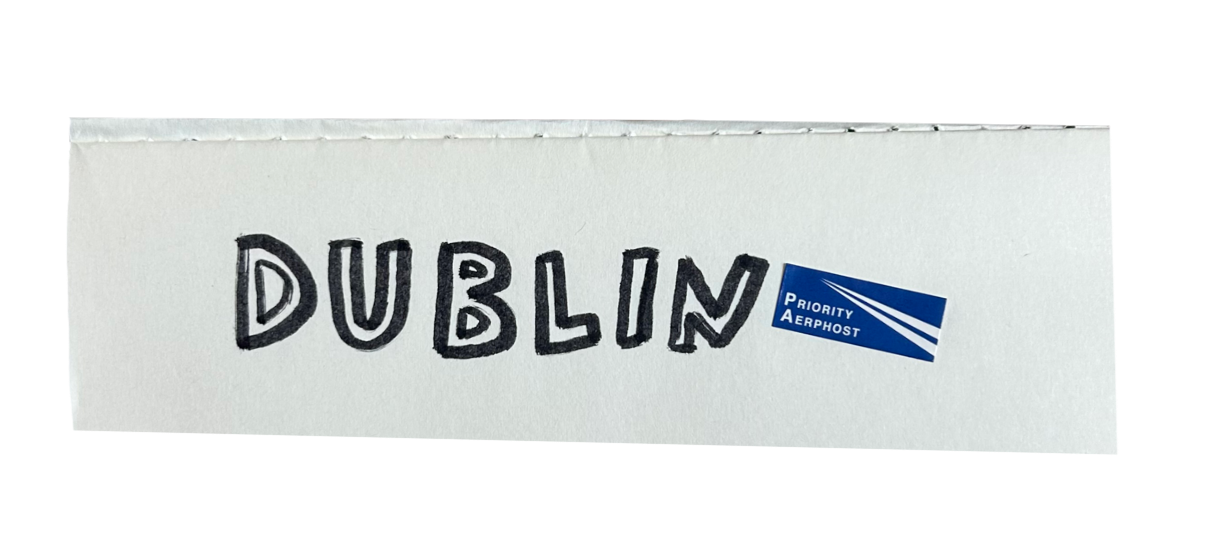
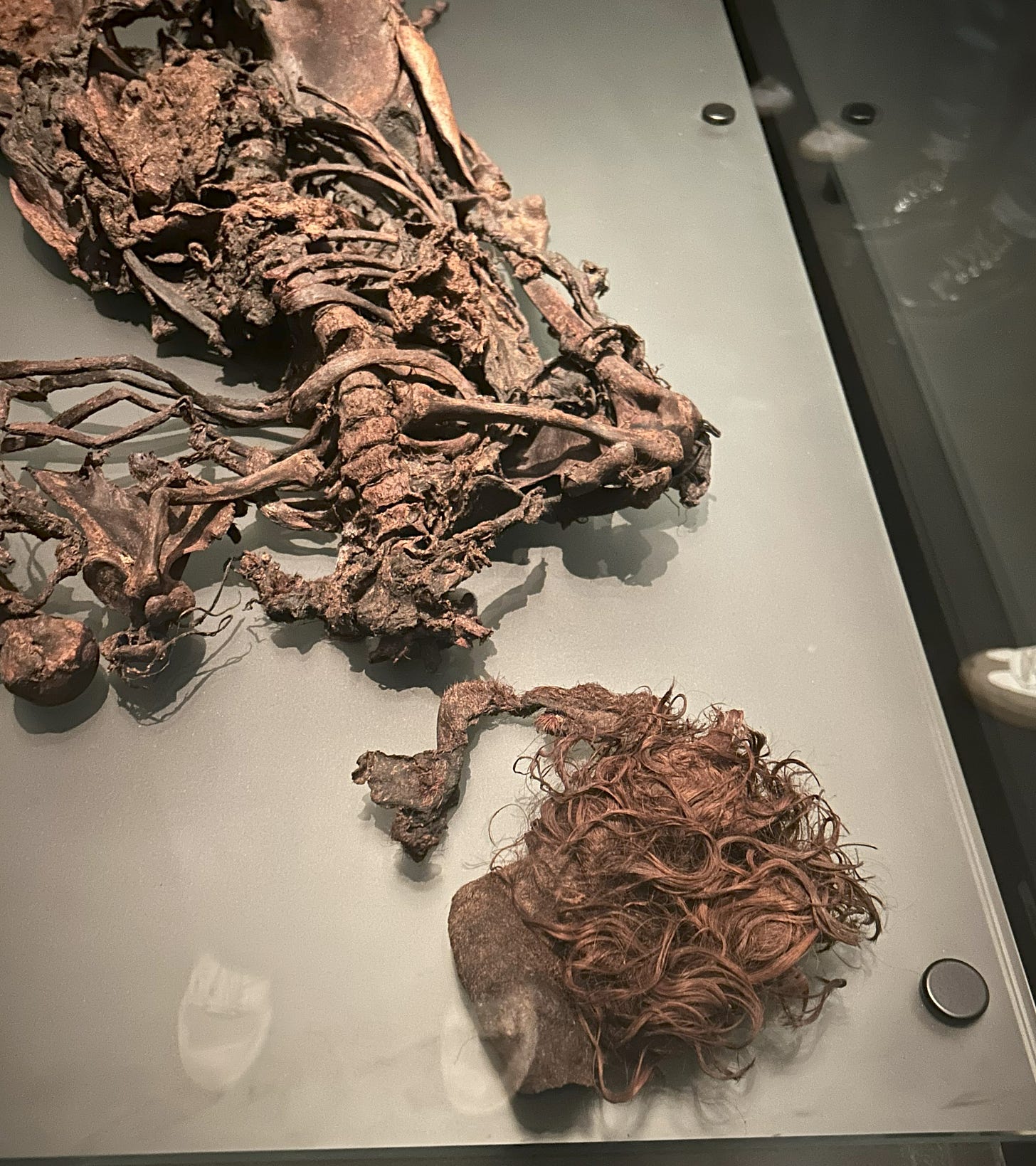
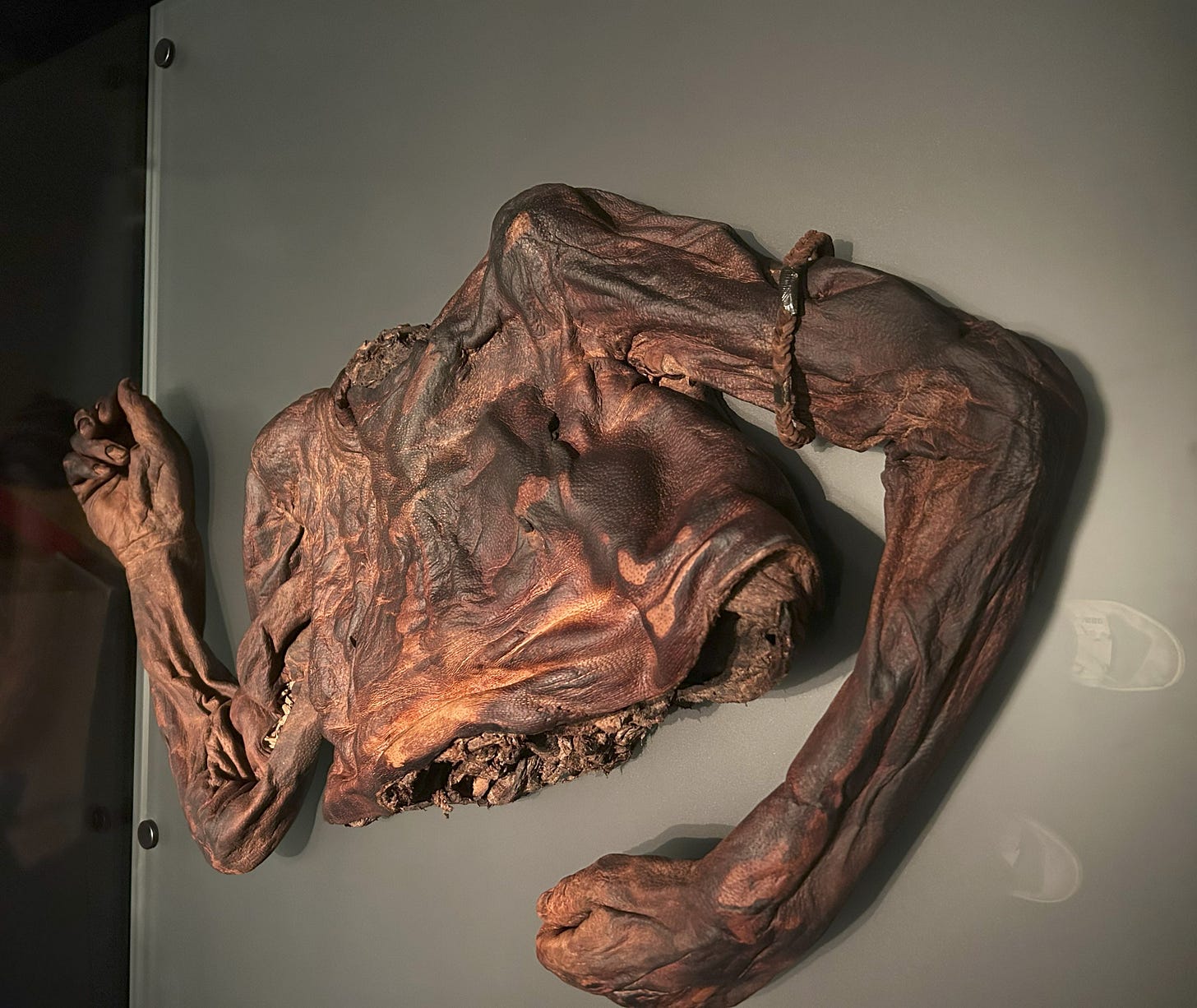


wowow thank you for sharing this! only just started reading through, but it is such an exciting reflection - love all things medievalism + what an experiencee(!)
Adored this — especially all the details and context you give about them, like the mermaids, and the wolfhounds (I really want one!) Defo going to check out those books you’ve recommended — I was wondering, because of what you write so poignantly about feeling the past, if you’d looked into Hauntology at all, it sounds bang up your street ☘️ 💚